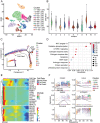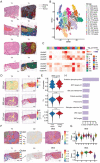Combined Single-Cell and Spatial Transcriptomics Reveal the Metabolic Evolvement of Breast Cancer during Early Dissemination
- PMID: 36594618
- PMCID: PMC9951304
- DOI: 10.1002/advs.202205395
Combined Single-Cell and Spatial Transcriptomics Reveal the Metabolic Evolvement of Breast Cancer during Early Dissemination
Abstract
Breast cancer is now the most frequently diagnosed malignancy, and metastasis remains the leading cause of death in breast cancer. However, little is known about the dynamic changes during the evolvement of dissemination. In this study, 65 968 cells from four patients with breast cancer and paired metastatic axillary lymph nodes are profiled using single-cell RNA sequencing (scRNA-seq) and spatial transcriptomics. A disseminated cancer cell cluster with high levels of oxidative phosphorylation (OXPHOS), including the upregulation of cytochrome C oxidase subunit 6C and dehydrogenase/reductase 2, is identified. The transition between glycolysis and OXPHOS when dissemination initiates is noticed. Furthermore, this distinct cell cluster is distributed along the tumor's leading edge. The findings here are verified in three different cohorts of breast cancer patients and an external scRNA-seq dataset, which includes eight patients with breast cancer and paired metastatic axillary lymph nodes. This work describes the dynamic metabolic evolvement of early disseminated breast cancer and reveals a switch between glycolysis and OXPHOS in breast cancer cells as the early event during lymph node metastasis.
Keywords: breast cancer; early dissemination; metabolism; single-cell RNA sequencing; spatial transcriptomics.
© 2023 The Authors. Advanced Science published by Wiley-VCH GmbH.
Conflict of interest statement
The authors declare no conflict of interest.
Figures






References
-
- Siegel R. L., Miller K. D., Fuchs H. E., Jemal A., CA: Cancer J. Clin. 2021, 71, 7. - PubMed
-
- Shek L. L., Godolphin W., Cancer Res. 1988, 48, 5565. - PubMed
-
- Zhang Y., Chen H., Mo H., Hu X., Gao R., Zhao Y., Liu B., Niu L., Sun X., Yu X., Wang Y., Chang Q., Gong T., Guan X., Hu T., Qian T., Xu B., Ma F., Zhang Z., Liu Z., Cancer Cell 2021, 39, 1578. - PubMed
Publication types
MeSH terms
Grants and funding
LinkOut - more resources
Full Text Sources
Medical
Molecular Biology Databases
